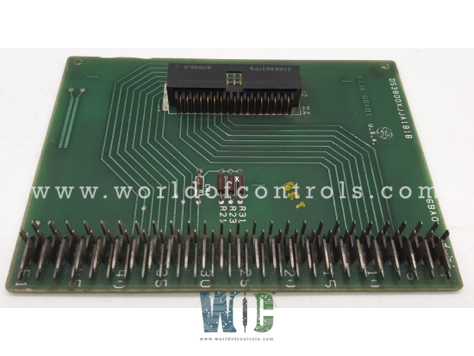
World Of Controls understands the criticality of your requirement and works towards reducing the lead time as much as possible.
DS3800XJJA1B1B - Single Driver Backplane Adapter Card is available in stock which ships the same day.
DS3800XJJA1B1B - Single Driver Backplane Adapter Card comes in UNUSED as well as REBUILT condition.
To avail our best deals for DS3800XJJA1B1B - Single Driver Backplane Adapter Card, contact us and we will get back to you within 24 hours.
SPECIFICATIONS:
Part Number: DS3800XJJA1B1B
Manufacturer: General Electric
Series: Mark IV
Product Type: Single Driver Backplane Adapter Card
Number of channels: 12
Input Voltage: 24 V dc
Operating temperature: -35 to 55 °C
Size: 8.24 cm high x 4.16 cm
Repair: 3-7 Day
Availability: In Stock
Weight: 2 lbs
Country of Origin: United States
FUNCTIONAL DESCRIPTION:
DS3800XJJA1B1B is a Single Driver Backplane Adapter Card manufactured and designed by General Electric as part of the Mark IV Series used in GE Speedtronic Gas Turbine Control Systems. A Single Driver Backplane Adapter Card is a hardware component designed to facilitate the transmission of signals between a device and a backplane. A backplane is essentially a large circuit board with connectors that allow multiple modules (such as circuit cards or devices) to communicate through a shared bus or set of connections. The Single Driver Backplane Adapter Card provides a single driver circuit that interfaces between the device's internal signals and the backplane, enabling communication with other modules connected to the same backplane.
This simplifies the design by reducing the number of active components needed for signal transmission, making the system more cost-effective and less complex. The driver typically includes circuitry that manages signal amplification or conditioning to ensure that the signal strength is adequate for transmission across the backplane. Signal degradation or distortion is minimized through techniques such as voltage level shifting, impedance matching, or signal equalization. The system using the Single Driver Backplane Adapter Card typically consists of devices that do not require multiple, concurrent signal paths but instead rely on sequential or single-path communication. It is ideal for simpler embedded systems or control systems where signal integrity and cost-efficiency are prioritized over complex multi-channel configurations.
FUNCTIONS OF SINGLE DRIVER BACKPLANE ADAPTER CARD:
WOC has the largest GE Speedtronic Control System Replacement Parts in Stock. We can also supply unused and rebuilt backed-up with a warranty. Our team of experts is available round the clock to support your OEM needs. Our team of experts at WOC is happy to assist you with any of your automation requirements. For pricing and availability on parts and repairs, kindly contact our team by phone or email.
What is a Single Driver Backplane Adapter Card?
A Single Driver Backplane Adapter Card is a hardware component that connects a device to a backplane, enabling communication between different devices or modules within an electronic system.
What is the purpose of the driver in a Single Driver Backplane Adapter Card?
The driver in the card is responsible for transmitting signals between the device and the backplane. It ensures that the signals sent from the device are correctly routed to other devices or modules connected to the same backplane.
How does signal amplification work in the adapter card?
Signal amplification is used to strengthen weak signals to ensure they are transmitted without loss of integrity. The adapter card may include circuits that increase the voltage of the signals to an appropriate level before sending them over the backplane.